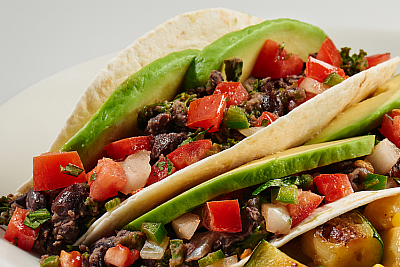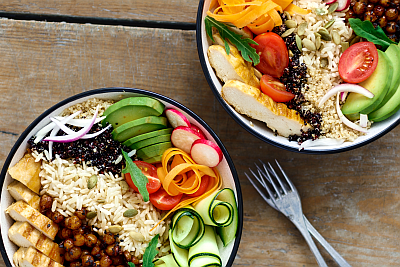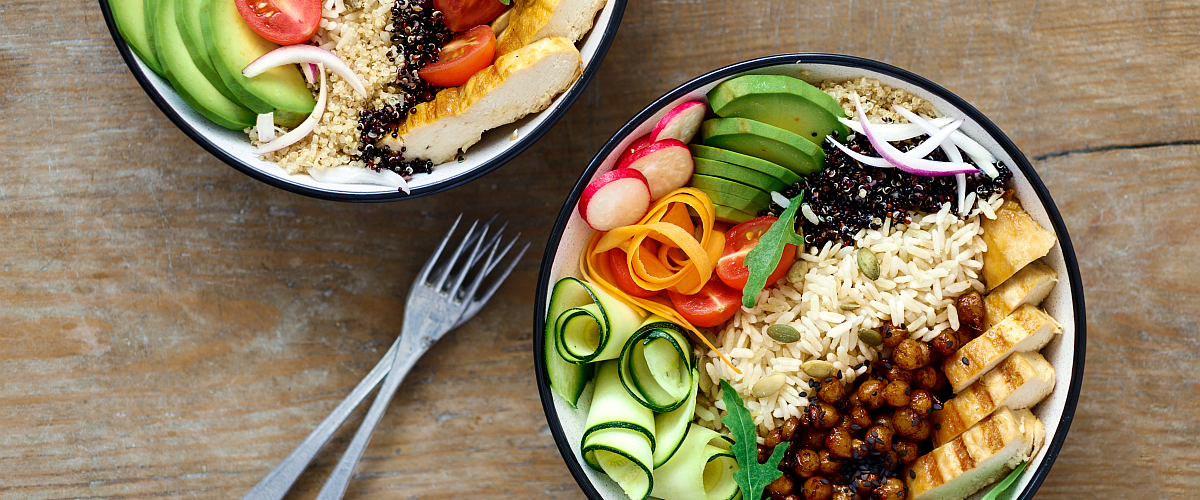Chances are you understand what it means to be vegetarian or vegan, but are you familiar with the concept of plant-forward? It simply means making plant foods like vegetables, fruits, whole grains, and legumes the majority of your plate. In fact, it’s so simple that many people eat plant-forward meals without even realizing it.

“It’s all about letting vegetables and other healthy plant foods become the stars,” says Aramark Chef Andrew Bergholtz. “And there are countless delicious ways to achieve that.”
Who better to teach us about plant-forward cooking than a professional chef? Knowing that this style of eating can be good for both our bodies and the world around us, we sat down with Chef Andrew to learn simple strategies for incorporating plant-forward techniques into everyday meals.
MAKE THE FLIP
Going plant-forward may mean flipping your thinking about what goes on your plate. Many of us grew up with meals where meat was the focus and everything else was a side dish. With plant-forward cooking, you put vegetables, fruits, whole grains and legumes at the center of your plate—with meat playing a supporting role for flavor or as a garnish.
“Cooking plant-forward is easier than you may think,” explains Chef Andrew. “Most of the ingredients you need are already in your pantry and fridge.”
He also points out that many everyday meals are naturally plant-forward. “There are salads, of course, but also pastas, soups, grain bowls, kabobs, pizza—the list goes on.” For example, you can load up a weeknight stir-fry with ingredients like carrots and mushrooms instead of chicken and serve it with brown rice or an ancient grain. The result is just as filling and tasty, and it lets those good-for-you veggies and whole grains shine.
FIND YOUR INSPIRATION
The Mediterranean diet is
ever-popular because it’s an easy, delicious, and healthy style of eating. It
also happens to be the perfect example of a plant-forward diet with its
emphasis on a variety of fruits, vegetables, whole grains, beans, and legumes,
as well as sources of healthy fats like fish, nuts,
and olive oil. If this diet speaks to you, let it be your guide for both travel
and taste!
Or you could get your meal ideas from in-season fruits and vegetables. “Take a look around the grocery store or farmers’ market, and notice what’s fresh and colorful,” Chef Andrew suggests. “Strawberries, for example, peak in May and early June. So grab a box. Add them to everything from cinnamon oatmeal to a mixed green salad.”
SWAP IT OUT
Perhaps the number one question about plant-forward
diets is, “How am I going to get enough protein?” But guess what. Protein
actually comes from both animal and plant sources. Legumes
(beans, peas, lentils), nuts, seeds, and tofu are all go-to sources for
plant-based protein.
So find your favorite and try using it in traditionally meat-based meals. With the right techniques, plant foods can take on flavors and textures similar to meat.
“With one or two swaps, you can make practically anything more plant-forward,” Chef Andrew encourages.

We have a few recipe ideas to get you started:
- While curries usually feature chicken or beef, you won’t miss the meat in our hearty, veggie-filled Pumpkin-Curry Vegetable Sauté.
- Throwing eggplant steaks (or any firm vegetable) on the grill adds a delectable, smoky flavor that evokes a meat-based meal.
- If your barbecue season isn’t complete without a burger, know that black beans and mushrooms are both grill-worthy contenders that can be served on a bun.
- Speaking of beans, let these Black Bean & Kale Tacos wow your family on taco night!
- Tofu can replace the meat and ricotta in lasagna. “Many chefs consider tofu a blank slate because it can soak up amazing flavors from sauces and marinades—like in our Sesame Tofu & Soba Noodle Salad recipe,” offers Chef Andrew.

Finally, store-bought products can open up yet another avenue for plant-forward cooking. There are plenty of meat substitutes on the market—mimicking sausages, meatballs, fish filets, and more—and they’ve come a long way, says Chef Andrew. So go ahead and call in a sub! We have a recipe for dressing up your next Gardenburger®.
MOVING
(PLANT) FORWARD
Adopting a
plant-forward diet can help make a healthy and sustainable lifestyle a reality.
Now that you know more about what that means, think about what could work for
you and your family. Think seasonally. Let plants shine at the center of the
plate. Be creative. Be bold.
Note: Since everyone’s health history and nutritional needs are so different, please make sure that you talk with your doctor and a registered dietitian to get advice about the diet and exercise plan that‘s right for you.


